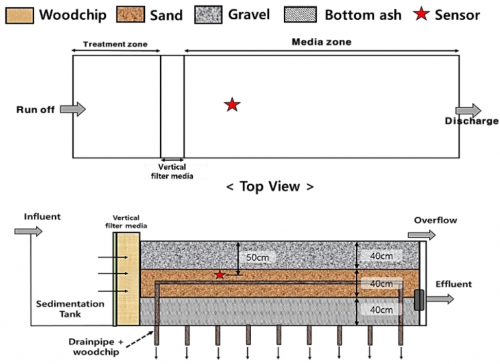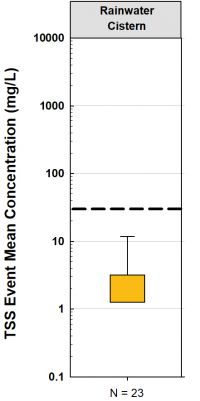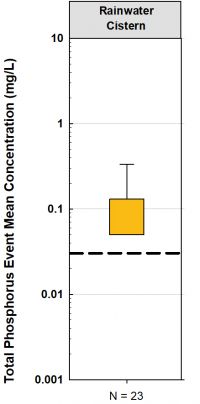Rainwater Harvesting: Performance
TSS Reduction[edit]
The performance results for Rainwater harvesting practices, located within TRCA's watershed originate from fours sites:
- Minto Hotel (Toronto)
- Metro Label 1 (Scarborough)
- Metro Label 2 (Scarborough)
- Brookside P.S (Scarborough)
The mean performance value recorded at each of the rainwater cistern practices, was to measure their ability to remove Total Suspended Sediments (TSS), which was calculated based on 24 separate recordings from 2007-2010 at each of the aforementioned locations listed above.
As can be seen in the corresponding boxplot the mean performance removal efficiency of the rainwater cistern practices monitored are well below the suggested guideline of 30 mg/L (Canadian Water Quality Guideline (CWQG), or (background (assumed at <5 mg/L)+ 25 mg/L for short term (<24 hour) exposure) (CCME, 2002[1]; (TRCA, 2021[2]).
The median value of the 24 samples taken was 1.25 mg/L whereas the mean was 3.98 mg/L, with a 4% guideline exceedance.
Phosphorus Reduction[edit]
The performance results for Rainwater harvesting practices, located within TRCA's watershed originate from fours sites:
- Minto Hotel (Toronto)
- Metro Label 1 (Scarborough)
- Metro Label 2 (Scarborough)
- Brookside P.S (Scarborough)
The mean performance value recorded at each of the rainwater cistern practices, was to measure their ability to remove Total Phosphorus (TP), which was calculated based on 24 separate recordings from 2007-2010 at each of the aforementioned locations listed above.
As can be seen in the corresponding boxplot, the mean performance removal efficiency of the infiltration trench practice monitored is not meeting the acceptable upper extent range of nutrients as it is 0.03 mg/L (30 µg/L) (Environment Canada, 2004[3]; OMOEE, 1994[4]).
The median value of the 24 samples taken was 0.05 mg/L whereas the mean was 0.11 mg/L, with a 100% guideline exceedance. Given the small sample size of just 24 grab samples further monitoring projects will be required to ensure that the results collected are as accurate as possible to ensure these practices can meet federal and provincial governments' guideline requirements for TP stormwater quality.
Please refer to the Phosphorus page and the additives page for more information on how LIDs can reduce contaminant loading in stormwater
Recent Performance Research[edit]
- (Jeon et al., 2022) - Long-Term Monitoring of an Urban Stormwater Infiltration Trench in South Korea
- This paper discusses a long-term monitoring program (8 years) to measure the performance of an infiltration trench and develop a model to be used to estimate influent and effluent stormwater quality based on average removal efficiencies. The study found that the specific trench configuration used (with a primary settling tank with a vertical layer of woodchips, along with horizontal layers of gravel, sand and bottom ash (see associated image to the right on this page). Over the 8-year study (2013 - 2022, in 2017 no monitoring took place due to construction) was able to remove an average of 83% of TSS and 79% of TP (39.31 mg/L & 0.17 mg/L respectively for effluent water quality) (Jeon et al., 2022[5]).

References[edit]
- ↑ Canadian Council of Ministers of the Environment (CCME). 2002. Canadian water quality guidelines for the protection of aquatic life: Total particulate matter. In: Canadian Environmental Quality Guidelines, Canadian Council of Ministers of the Environment, Winnipeg
- ↑ TRCA. 2021. Spatial Patterns (2016-2020) and Temporal Trends (1966-2020) in Stream Water Quality across TRCA’s Jurisdiction Prepared by Watershed Planning and Ecosystem Science. https://trcaca.s3.ca-central-1.amazonaws.com/app/uploads/2021/10/29113334/2016-2020-SWQ-Report-v11_FINAL_AODA-FA.pdf
- ↑ Environment Canada. (2004). Canadian guidance framework for the management of phosphorus in freshwater systems. Ecosystem Health: Science‐based solutions report no. 1–8. Cat. No. En1–34/8–2004E.
- ↑ Ontario Ministry of Environment and Energy (OMOEE), 1994. Policies, Guidelines and Provincial Water Quality Objectives of the Ministry of Environment and Energy. Queen’s Printer for Ontario. Toronto, ON.
- ↑ Jeon, M., Guerra, H.B., Choi, H. and Kim, L.H. 2022. Long-Term Monitoring of an Urban Stormwater Infiltration Trench in South Korea with Assessment Using the Analytic Hierarchy Process. Water, 14(21), p.3529.
- ↑ Jeon, M., Guerra, H.B., Choi, H. and Kim, L.H., 2022. Long-Term Monitoring of an Urban Stormwater Infiltration Trench in South Korea with Assessment Using the Analytic Hierarchy Process. Water, 14(21), p.3529.

